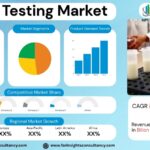
Agriculture Robots Market Size, Trends Analysis Research Report By Type (Milking Robots, Harvesting Robots, Weeding Robots, Seed Planting Robots, Crop Monitoring Drones, Others), by Application (Dairy Management, Harvest Management, Soil Management, Irrigation Management, Crop Monitoring), by Component, and By Region Global Market Analysis And Forecast, 2025-2034
Oct-2025 Formats | PDF | Category: Agriculture | Delivery: 24 to 72 Hours
Global revenue from the Agriculture Robots market is expected at US$ 18.6 Billion in 2025 and has been blunt to present at a CAGR of 25.8% to extent US$ 96.8 Billion by the end of 2034.
Agriculture Robots Market Research Summary
The market for agriculture robots is growing very fast and is expected to continue to grow at a high speed in the next years. This is primarily due to the increasing adoption of automation technologies in the agriculture sector. There is a strong demand for such robots from the market due to their potential for energy-efficient and environmentally friendly agriculture. These robots are equipped with advanced technologies such as GPS, sensors, and AI algorithms to perform tasks like seeding, weeding, spraying, and harvesting with precision and accuracy.
In the future, the agriculture robots market will be dominated by technological innovations in machine learning and robotics. The changes that will be introduced will result in robots being able to make independent choices based on the latest data. This, in turn, will allow them to be much more efficient and productive in the field. Moreover, Internet of Things (IOT) technology interacting with Agriculture robots will surely transform the ensuing market by simplifying communication and data sharing between the District Farm Equipments and the robots.
The agriculture robots market will continue to thrive and innovate over the next few years, with the primary objectives of increasing productivity, cutting down labor costs, and promoting sustainable agricultural practices.
Market Insights
- By 2024, the Agriculture Robots Market will be a major contributor to the global economy, a growth spurt to be expected from North America.
- Precision farming techniques that have been widely adopted in the region are the main reasons for such a regional market expansion. Besides, the urban population in the U.S. is forecast to reach about 83% in 2024, which makes the introduction of new technological equipment in agriculture, for example, robots that can help to produce food, a very logical solution to the problem of food shortage.
- The largest revenue share has been predicted for the autonomous tractors segment among the segments in the Agriculture Robots Market, which is mainly attributed to the increase in the demand for efficient farming practices and the use of labor-saving technologies.
Market Dynamics
Trends
Increased Adoption of Autonomous Systems: The demand for autonomous robots that can carry out operations like seeding, weeding, and harvesting with little human intervention is rising in the market.
Integration of AI and Machine Learning: The use of artificial intelligence and machine learning algorithms is making agriculture robots more intelligent, thus they can now make decisions in real-time based on data analytics.
Precision Agriculture Techniques: The use of precision agriculture techniques is increasing, where robots are being utilized to adjust the usage of water, fertilizers, and pesticides, thus resulting in higher crop yields and better conservation of resources.
Expansion of Robot-as-a-Service (RaaS) Model: The companies are providing robots through a subscription model which is helping the farmers to get advanced agricultural robotics technology at a reasonable price without paying a large amount upfront.
Growth Drivers
More and more farmers are using precision agriculture methods to increase their crop yield and lower their labor costs.
There is a growing need for autonomous farming equipment as a solution to labor shortage and as a means to enhance operational efficiency.
The government is backing up initiatives that encourage the use of high-tech devices in the agriculture sector aiming at food security and sustainability.
The progress in technologies such as robotics, artificial intelligence, and sensors is the main reason behind the inflow of new and cheaper agricultural robots in the market.
Farmers are increasingly realizing the advantages of using robots for the completion of the tasks like planting, weeding, and harvesting, hence, their productivity and profitability will rise.
Restraints
Limited technical expertise: The intricate nature of the agriculture robots might lead to a requirement for annotating the knowledge of specialized technical, thus impeding the adoption.
High initial investment: The upfront cost of implementing agriculture robots, including purchasing, installation, and maintenance, can be a significant barrier for farmers.
Regulatory challenges: Changing regulations and standards regarding the use of robots in agriculture may cause market players to be uncertain and have trouble complying with them.
Limited adaptability: Some agricultural robots may find it challenging to perform efficiently in a wide range of environments and deal with different crops, thereby limiting their use in certain farming practices.
Data security concerns: Farming robots that collect and manage vast amounts of data raise privacy and security concerns, which can, therefore, hinder market growth.
Opportunities
The demand for precision farming techniques has led to the increased use of agriculture robots.
The focus on sustainable farming practices has resulted in the growth of the agriculture robots market.
Advancements in technology for robotics and artificial intelligence are supporting the development of agriculture robots.
The increase in labor costs and shortage of skilled farm workers are the reasons for the rise in the demand for autonomous farm machinery.
Government programs encouraging the use of robotics in agriculture to increase productivity and efficency.
Such possibilities point to the positive growth prospects of the agriculture robots market in the coming years, thus making it a fascinating sector for investment and innovation.
Challenges
Regulatory Hurdles: Strict regulations and increased requirements for compliance related to the use of robotics in agriculture may limit the growth of the market.
High Initial Investment: The high upfront cost of agricultural robots is the main factor that keeps the farmers, especially small-scale ones, from buying such devices.
Limited Adaptability: Some robotic devices in agriculture might not be sufficiently versatile to carry out multiple tasks efficiently, thus their applications may be co Limited.
Data Security Concerns: The introduction of agriculture robots that collect and handle large amounts of data has raised concerns regarding data privacy and security.
Technological Integration: The use of robots together with the already existing farm equipment and systems may create difficulties, thus needing further investments in the infrastructure and training.
Agriculture Robots Market Top Companies Covered In This Report:
Evaluate The Strategic Positioning And Innovation Pipelines Of Leading Market Companies-From Multinational Enterprises To Disruptive Regional Firms. Understand How Key Players Are Innovating, Expanding, And Capturing Value, And Use Competitive Benchmarks To Plan Your Next Move.
- Deere & Company
- DJI
- CNH Industrial N.V.
- AGCO Corporation
- DeLaval
- Trimble, Inc
- BouMatic Robotics
- Lely
- Kubota Corporation
- Ageagle Aerial Systems INC.
- Yanmar CO.
Agriculture Robots Market Company News 2024 and 2025
Deere & Company
Announced a strategic partnership with SpaceX to provide Starlink satellite connectivity for rural/agriculture equipment in 2024
DJI
In 2025 launched the Agras T100, T70P and T25P spray drones globally. Also reported ~400,000 agricultural drones in use globally and strong growth.
AGCO Corporation
In 2024 completed a major portfolio shift with the closing of its JV with Trimble, Inc. (PTx Trimble) focused on mixed-fleet precision ag and autonomy.
CNH Industrial N.V
In early 2024 displayed and sponsored robotics event participation for its brand (New Holland) at FIRA 2024, showcasing its “Stout Smart Cultivator” AI-robotic implement and other autonomous solutions.
Key Segments
Segmentation By Type
- Milking Robots
- Harvesting Robots
- Weeding Robots
- Seed Planting Robots
- Crop Monitoring Drones
- Others
Segmentation By Application
- Dairy Management
- Harvest Management
- Soil Management
- Irrigation Management
- Crop Monitoring
Segmentation By Component
- Hardware
- Software
- Services
Global Geographic Coverage:
The Report Provides In-Depth Qualitative And Quantitative Data On The Agriculture Robots Market For All Of The Regions And Countries Listed Below:
North America
The Agriculture Robots Market in North America is expected to have a significant increase during the coming years. The economic situation in the United States looks quite promising, as the GDP Growth is forecasted to be 2.8% with the inflation rate remaining at 1.9%. A government program providing subsidies to producers of agricultural automation technologies is one of the most important factors promoting the market of the U.S. This subsidy, by which farmers are encouraged to use robotics technology, has driven the expansion of the market. Direct sales to large-scale farming operations are the main channel for agricultural robots in North America, while the partnership with equipment manufacturers is the fastest-growing channel. The end-users in this market are mostly concerned about the environment and the origin of the products, thus, these aspects should be the key factors for product acceptance in the market. On the other hand, in emerging markets where price and status are the most important factors, a demand for cheap robotic solutions which enhance farming productivity and efficiency is rising.
Europe
The Europe Agriculture Robots Market is changing rapidly and the GDP Growth and Inflation Rate that are forecasted have a significant impact on the preferences of consumers and market dynamics. Germany is setting the trend with her powerful economy and a GDP growth of 2 % that is projected. France is not far behind with a growth rate of 1.8 %. A government subsidy that encourages the use of agricultural robots is the main reason for the change in Spain, thus differentiating her from other countries. The leading channel in Italy is online retail whereas the quickest developing channel in the UK is through partnerships with local farmers.
Consumers all over Europe are focusing on the sustainability and ethical sourcing of products which they consider as a must-have in the market. Nevertheless, in a number of emerging markets in Eastern Europe, price and status are still the main factors influencing consumer decisions and this thus calls for the development of customer-specific marketing strategies in these areas.
Asia Pacific
The Agriculture Robots Market in Asia Pacific and its Sub-Regions is going through a major transformation with a projected GDP growth of X% and an inflation rate of Y%. In Japan, the government subsidy for the adoption of agricultural robots is a major factor, thus it is having a significant impact on the market dynamics. In China, the predominant channel for agriculture robots is direct sales to large-scale farms, whereas e-commerce is the fastest-growing channel in India. Consumers in South Korea are buying agricultural robots with a view to sustainability and ethical sourcing. However, in Indonesia and Vietnam, price and status are the leading factors in the development of the market. As the market keeps on changing, it is very important for industry players to understand the different factors that influence each country’s adoption of agriculture robots if they want to take advantage of the region’s growth potential.
Middle East and Africa
The Agriculture Robots Market in the Middle East and Africa is set to grow substantially, as the region is expected to have a GDP growth of 3.5% and an inflation rate of 2%. Egypt is an example where the government’s subsidy program for modern agricultural technologies is the main local driver of the market, thus pushing the adoption of robots among farmers. The main channel for these products is direct sales to farmers, whereas online retail is the fastest-growing channel because of the increasing digitalization.
Sustainability and ethical sourcing are regarded as essentials by consumers in South Africa, thus forcing companies to give priority to these factors in their supply chains. In markets like Nigeria and Kenya, price and status are still the main factors, with consumers primarily focusing on affordability and brand reputation. The regional differences in consumer preferences underscore the importance of having distinct marketing strategies for each sub-region of the Middle East and Africa.
Frequently Asking Questions
What is the Agriculture Robots market size and growth forecast?
Agriculture Robots Market is predicted to grow from USD 18.6 Billion in 2025 to approximately USD 96.8 Billion by 2034. the industry is estimated to expand at a CAGR of 25.8%.
Who are the key players in the Agriculture Robots market?
The Agriculture Robots Market Includes Major Companies Deere & Company, DJI, CNH Industrial N.V., AGCO Corporation, DeLaval, Trimble, Inc, BouMatic Robotics, Lely, Kubota Corporation, Ageagle Aerial Systems INC., Yanmar CO., Others.
What are the current and future trends for Agriculture Robots market?
Current trend: Increasing adoption of precision agriculture techniques driving the growth of Agriculture Robots market. Future trend: Advancements in artificial intelligence and automation technology will lead to more efficient and cost-effective Agriculture Robots in the market.
What are the challenges facing the Agriculture Robots market?
Challenges facing the Agriculture Robots market include high initial investment costs, limited awareness and acceptance among farmers, and the need for specialized technical skills to operate and maintain the robots effectively.
Which regions dominate the Agriculture Robots market?
North America and Europe dominate the Agriculture Robots market, driven by advanced farming technologies and high adoption of automation in agriculture.
Report Features
This report gives the most complete information. The report on Agriculture Robots Market format has been designed so that it can provide the best value to the business. It offers crucial insights into the market’s dynamic and will aid in strategic decision-making for current players as well as those looking to join the market.
What Deliverables Will You Get in this Report?
Key questions this report answers | Relevant contents in the report |
How big is the sales opportunity? | In-depth analysis of the Global Agriculture Robots Market |
How lucrative is the future? | Market forecast and trend data and emerging trends |
Which regions offer the best sales opportunities? | Global, regional and country level historical data and forecasts |
Which are the most attractive Agriculture Robots market Key segments? | Market segment analysis and |
Which are the top Key players and Their Agriculture Robots market positioning? | Competitive landscape analysis, Market share analysis |
How complex is the business environment? | Porter’s five forces analysis, PEST analysis, Life cycle analysis |
What are the factors affecting the Agriculture Robots market? | Drivers & Restraints |
Will I get the information on my | Customized Report as per your Business Needs Our analysts will work directly with you and understand your needs Get data on specified regions or segments, competitor and Vendors Data will be formatted and presented as per your requirements Any Requirement Contact Us: Https://Www.Forinsightsconsultancy.Com/Contact-Us |
Table of Contents
For TOC Contact us: https://forinsightsconsultancy.com/contact-us/






